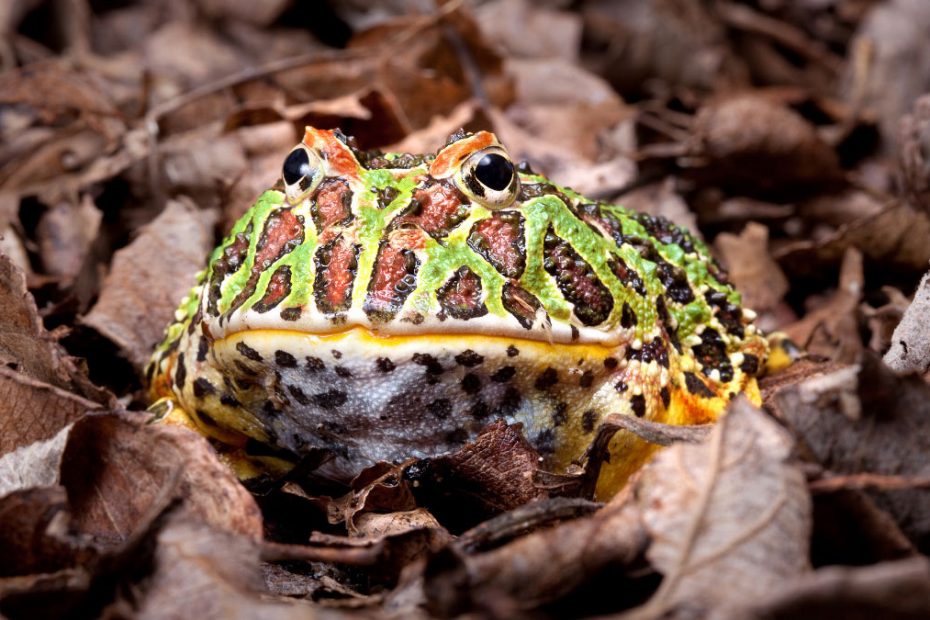Pacman frogs, also referred to as horned frogs, are large, terrestrial frogs that are native to South America. These frogs are well known for their round and flattened bodies, in addition to a wide mouth that can deliver a powerful bite.
These unique frogs get their name from their round body shape and large terrariummouth—which resembles PAC-MAN, the video game character.
Pacman frogs feature rough, bumpy skin with varying colors that range from yellow to brown, and orange, which camouflages them in their natural habitat.
That said, it is important to know more about these unique frog species for animal enthusiasts, amphibian conservation organizations, and even pet owners. Understanding their behavior can go a long way in promoting better amphibian conservation efforts for them in the wild.
Moreover, it helps you give this amphibian the best care if you decide to keep it as your pet.
Taking good care of your Pacman frog pet will keep it happy and healthy—increasing its overall life quality and maximum longevity in captivity.
The following guide comprehensively covers everything you need to know about the Pacman frogs, including their physical characteristics, habitat, behavior, reproduction, diet, care, and housing.
In addition, we have provided some interesting and little-known facts about Pacman frogs.
Species name:
- Common names: Pacman frog, South American horned frog, Argentine horned frog, ornate horned frog.
- Scientific name: Ceratophrys
Classification:
- Family: Ceratophryidae
- Genera: Ceratophrys
- Species: PacMan frog exists in multiple species, classified based on their skin colorations and markings. Some of these species include Ceratophrys ornata, Ceratophrys cranwelli, Ceratophrys aurita, Ceratophrys calcarata, Ceratophrys stolzmanni, and Ceratophrys cornuta.
Physical Characteristics
The Pacman frogs are easily recognized by their unique physical characteristics that separate them from other species of frogs.
They are typically large and terrestrial frogs. Adult PacMan frogs grow as big as around 5 to 7 inches, though females are usually larger than males, which only grow to about 3-4 inches. Note these frogs have bodies just as wide as their lengths.
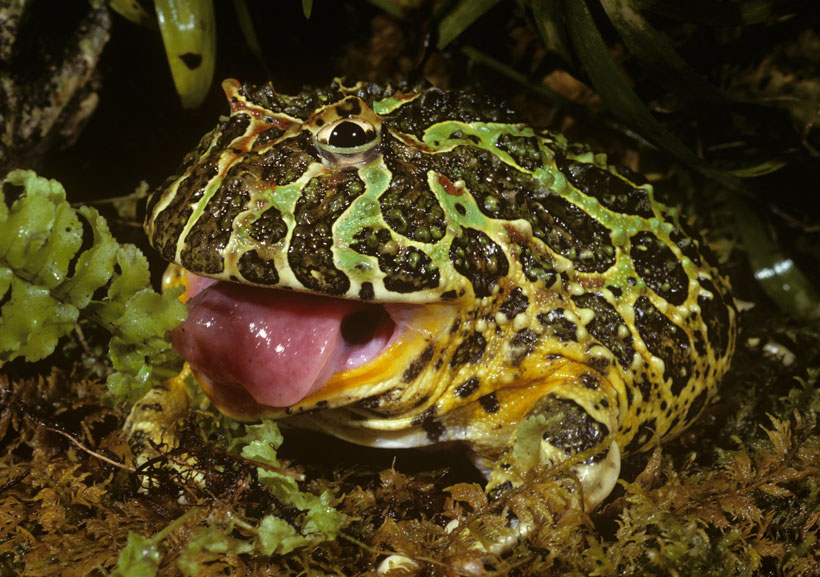
Pacman frogs feature round-shaped and flattened bodies in addition to short and sturdy hind legs that enable them to quickly move on land.
A round body and wide mouth give these frogs their name PacMan. This frog anatomy resembles the arcade game character that goes by the same name.
Pointy eyelids on top of their heads that look like horns also give them the name horned frogs.
Rough, bumpy skin helps these frogs blend well with their environment and prevent predation.
Colorations and markings:
As for the skin markings and colorations, these frogs come in a wide variety of blotch patterns (specific to different species) across their backs.
These range from tan to brown, red, green, and/or yellow combinations. Males usually appear more colorful than their female counterparts.
It is also worth noting that Pacman frogs come in a wide variety of species, each having its own distinct set of characteristics.
The Argentine horned frog is the most common species and usually features green or brown coloration. However, it can also be orange, yellow, or albino.
The PacMan comes in as many as 18 color morphs. Different species of this frog are categorized based on their skin color and patterns.
Some of the most common species include:
- Strawberry Pacman frog
- Apricot Pacman frog
- Translucent Pacman frog
- Albino Pacman frog
- Purple Pacman frog
- Sunburst Pacman frog
Unique Pacman frog adaptations to survive in the wild:
Just like other frog species, the Pacman frog has developed several morphological adaptations to enable it to survive in harsh conditions. Some of these adaptions include:
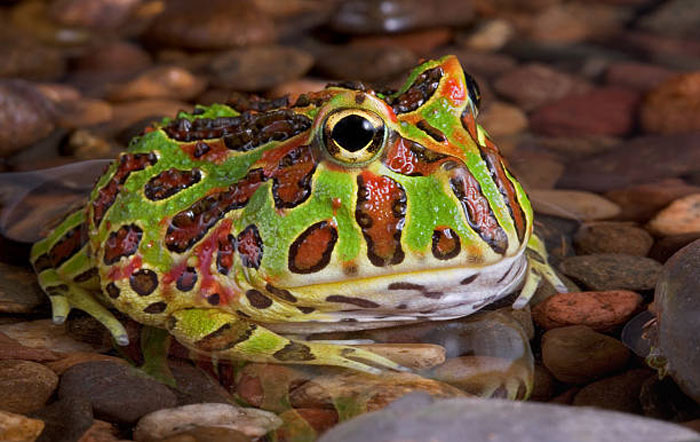
- Burrowing lifestyle: Since the natural frog habitats are prone to temperature, humidity, and rainfall fluctuations, they cope by burrowing into the substrate where humidity and temperature levels are more stable.
- Bumpy skin: It enables the amphibians to easily retain moisture and thus help in keeping them moist as well as regulate their body temperatures.
- Camouflage: Their skin coloration enables them to blend with their environment and thus avoid predation. For instance, Argentine horned frog skin has a molten pattern that resembles leaf litter on forest floors or the bark of trees while Amazon horned frog species features bright coloration to make predators think it is non-palatable and toxic.
Habitat and Behavior
Pacman frogs are native to South America’s humid and tropical regions. They are mainly found in countries including Brazil, Paraguay, Argentina, and Uruguay.
These frogs are usually widespread across a variety of habitats ranging from rainforests to wetlands and even grasslands.
You will mostly find these frogs residing in areas that provide adequate moisture and cover, e.g. environments with dense vegetation and water sources such as ponds or streams.
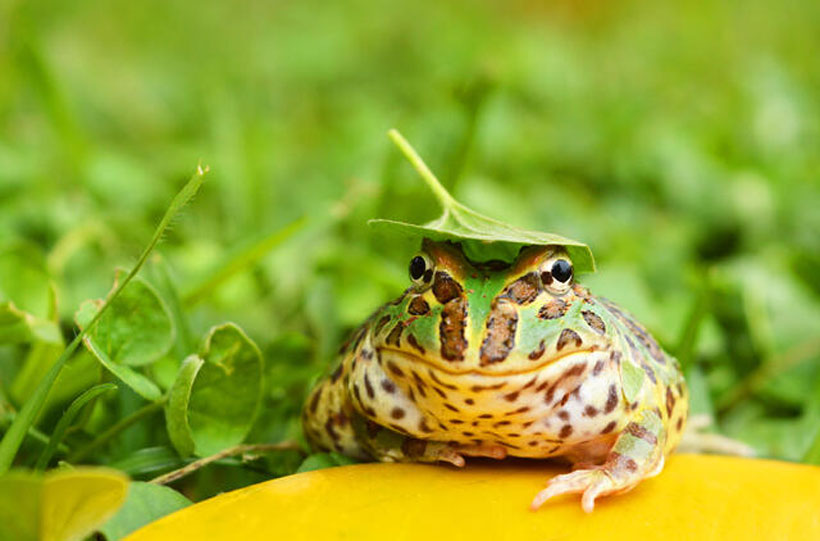
Solitary and nocturnal behavior:
However, PacMan frogs are solitary creatures in the wild. They are also nocturnal, meaning they are mostly active at night. Pacman frog behavior during the day involves burrowing in substrates or hiding under the cover of vegetation to avoid predation and stay cool.
At night, they get out of their hiding to hunt for food and mating partners. Their camouflage capabilities and powerful bites give them an edge when it comes to capturing various types of prey (more details on what this frog eats coming up later in this article).
Mating habits and breeding behavior
PacMan frog has unique mating rituals and breeding behavior. The males usually let out low-pitched croaks to attract females for mating.
When a female shows up, the male PacMan grasps her in a mating position and then fertilizes her eggs as she lays them.
Pacman frog species usually lay their eggs in shallow waters, where they then metamorphose into tadpoles and then develop into froglets.
Care and Housing
Below are some helpful tips on how to take good care of your Pacman frog pet to keep it happy and healthy.
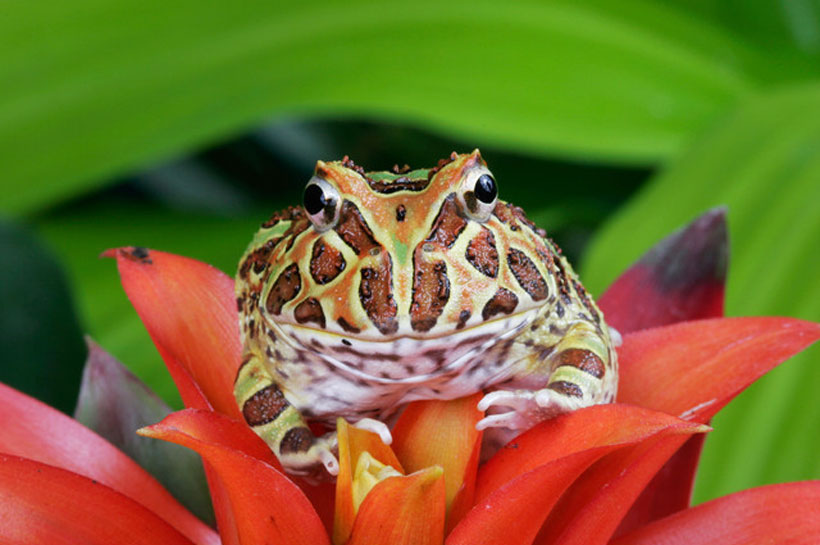
Housing:
Here is a step-by-step guide for setting up your Pacman frog housing:
Step 1. Choose the right size of housing
One Pacman frog will comfortably live in a 20-gallon tank. We recommend getting a cage-top-style enclosure as it helps maintain the optimal temperature and humidity for the frog’s environment.
NOTE: You should not consider any tank mates for this frog, as it will most likely eat them due to its voracious appetite.
Step 2. Choose the perfect substrate
Get a substrate that mimics that of the frog natural habitats as much as possible. Loose coconut fiber, made from coconut husks, can make a suitable substrate.
Be sure to mist this substrate daily to help maintain your terrarium humidity between 50 and 80%. But avoid making the substrate watery.
Besides, we recommend adding leaf litter, moss, or some plants to provide your pet frog with somewhere to burrow and hide.
Adding live plants to the substrate can help increase the enclosure humidity. However, make sure you only include reptile-safe plants such as aloe, pothos, ficus, philodendrons, dracenae, and spider plants.
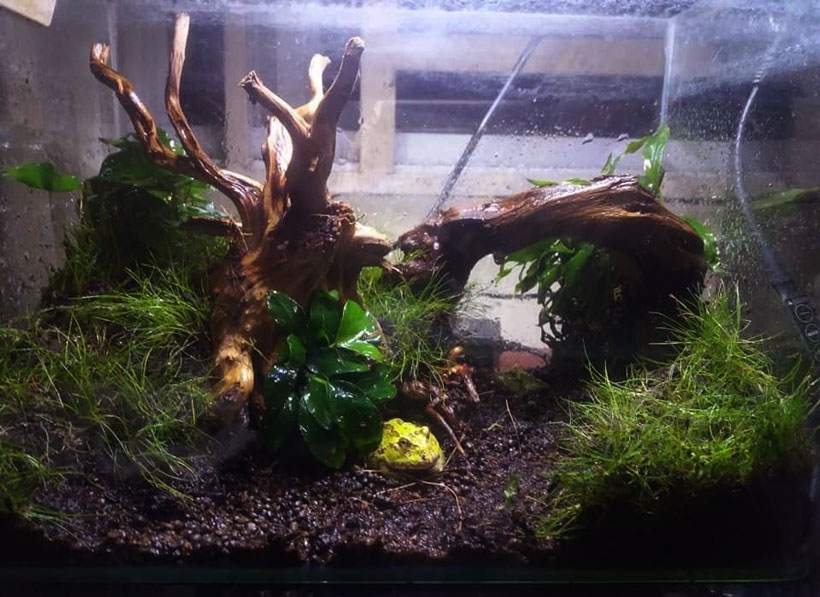
Step 3. Water requirements
You should also add a shallow water dish (around 1 to 1 ½ inches) in the tank for your frog to drink or sit in without risk of drowning, as PacMan frogs are poor swimmers. The dish should also be large enough for the Pacman to sit in comfortably.
Your frog is likely to spend most of its time here depending on how humid the tank is. Make sure you set up the water dish in the warmer part of the enclosure to keep it from getting too cold.
Step 4. Create hiding spots
Adding hiding spots in the enclosure is also recommended to provide the frog with a sense of security and privacy. A hiding hut can make a suitable hiding spot. Make sure it’s big enough for it to enter and turn around while inside.
Step 5. Setting up the heat and lighting
The correct temperature for your Pacman frog environment should be around 82 degrees Fahrenheit during the daytime. However, it can drop to about 78 degrees F at night.
For the heat source, we recommend using an under-tank heater instead of an overhead heater which can easily dry your frog.
Lighting for your PacMan should be maintained at a 12-hour light cycle followed by a 12-hour dark cycle at night—just like in its wild environment.
Note that these frogs may prefer more subdued lighting and regular lighting may just be enough for them.
The ideal lighting options to consider include fluorescent fixtures, though some folks also recommend using the UVA/UVB light.
Keeping your Pacman frog healthy:
In addition to setting up the perfect housing for your PacMan frog, you should also mind its overall health and wellness. Here are some helpful tips on how to keep your PacMan pet healthy:
Hygienic living space: Your PacMan frog requires a clean and hygienic environment. As such, you will need to regularly clean its enclosure by removing any uneaten foods, dead insects, frog waste, soiled substrate, etc.
Additionally, you should keep the water in its tank clean and free of any harmful bacteria that may make your pet sick. Disinfect the water dish frequently and change the water to keep your frog healthy. Clean the entire frog tank once every month.
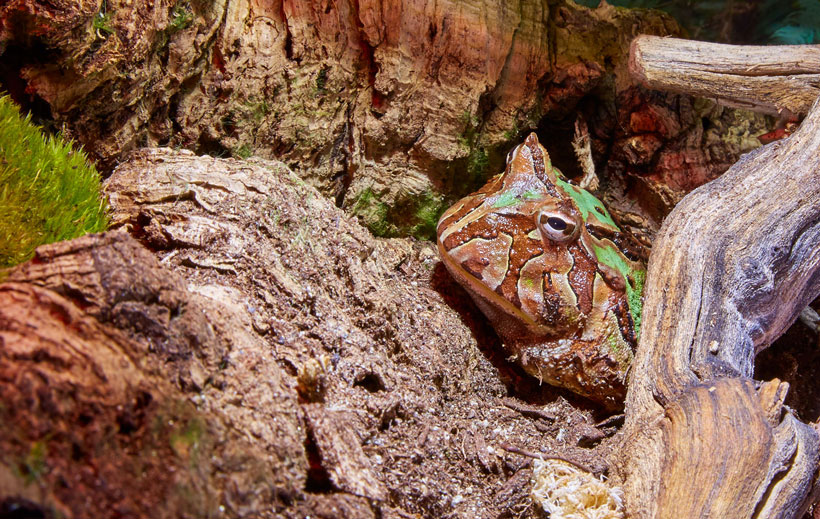
- Veterinary care: Regular veterinary clinics are also key to ensuring your frog stays healthy and at the same time address any underlying health issues.
You should also monitor your frog regularly for signs of illnesses such as lethargy, sunken eyes, weight loss, change in appetite and defecating habits, etc., and seek the vet’s help immediately.
- Provide a healthy diet: A balanced and nutritious diet for your PacMan frog pet is also essential to ensure it gets all the necessary nutrients to keep its body strong and healthy. Pacman frogs are easy to feed, as they just require insects such as crickets, beetles, or common prey from pet stores such as waxworms, mealworms, etc.
Common issues and problems that may arise for Pacman owners:
Here are some of the most common problems that PacMan frog pet owners experience and tips for addressing them:
- Bacterial and fungal infections: These are quite common amphibian ailments and your PacMan frog is not an exception. Common signs of these infections include swelling, redness, and puss. If you notice any of these signs, seek a vet’s help immediately.
- Parasitic infections: The frogs are also susceptible to parasites, which can lead to various health issues. Yearly fecal examinations by a reptile vet can help ensure your pet stays free of parasites.
- Respiratory infection: If you house your PacMan frog in an enclosure with low humidity, it may also develop respiratory infections. Key symptoms include wheezing, lethargy, and drooling.
- Dehydration: PacMan frog requires a humid environment, so poor humidity can lead to the animal drying off which results in dehydration. Misting the frog’s enclosure regularly and providing a shallow water dish for it to soak can help keep away dehydration.
- Poor husbandry: Issues such as inappropriate temperatures, poor hygiene, inadequate substrate, etc., may cause your frog to develop various health problems. Not cleaning the waste in your pet’s enclosure can also lead to ammonia poisoning, which can be fatal.
Diet and Feeding
Pacman frog is a hungry frog. It attempts to eat anything that moves within a striking distance from where it sits. Pacman frog diet mostly consists of insects, small reptiles, small mammals, small rodents, and small fish.
It prefers the sit-and-wait hunting strategy, where they sit and wait for the prey to come within striking distance and then attack it. Since the frogs are not as fast, they camouflage and use their powerful bite to capture prey in their natural habitat.
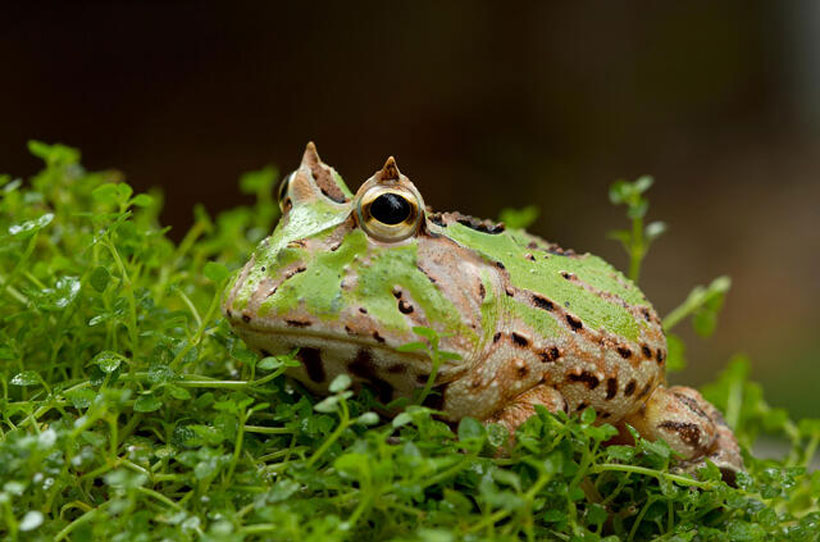
The frogs also exhibit cannibalistic behavior where they may eat other species of smaller frogs or even their fellow smaller PacMan frogs. That’s why it’s recommended to keep them alone in tanks to keep them from feasting on their tank mates.
In captivity, you should feed these frogs live prey such as insects, small reptiles, small mammals, etc.
Besides, you should also consider feeding your PacMan frog vitamins and mineral supplements. Calcium supplements, for instance, help keep off metabolic bone disease (MBD) which is quite common in pet frogs.
A good feeding method is dusting the supplement over the prey’s food before giving it to the frog.
Mistakes to avoid when feeding your PacMan frog:
One of the common mistakes in feeding PacMan is overfeeding. This can lead to obesity as well as other health issues. Just make sure you only feed it the appropriate size based on its age and size.
Alternatively, simply follow the rule of thumb that recommends feeding the frog an amount of food that is around the same size as its head.
Ensure you feed your frog pet a balanced, varied diet to ensure it gets all the necessary nutrients. You should feed an adult PacMan frog every 2-3 days while a baby PacMan needs to be fed more frequently.
Impaction is also likely to happen when the frog accidentally ingests substrates alongside its prey. Feeding your pet in a separate container can help prevent this occurrence.
Fun Facts About Pacman Frogs:
Here is a quick list of interesting facts about Pacman frogs you did not know:
- Pacman frogs have an impressive lifespan of around 15 years in their natural habitats. However, their lifespan in captivity is around 10 years.
- A female Pacman frog can lay up to 2000 eggs per clutch, which hatch into tadpoles. These hatchlings then metamorphose into froglets and eventually adult frogs in weeks.
- PacMan frogs have voracious and aggressive feeders and may even bite your fingers by mistaking them for prey. They eat just anything that comes their way, and may even be cannibalistic enough to eat fellow PacMan frogs.
- Skin shedding is part of the frog’s life. Once they shed it, they may eat it as it may contain some helpful nutrients.
- PacMans use a variety of vocalizations to communicate with each other, including croaking, hissing, and growling.
Conclusion
This article has just covered everything you need to know about these unique frog species including their physical characteristics, behavior, habitat, diet and feeding habits, and housing and Pacman frog care requirements.
They are also popular exotic pets in the US due to their low maintenance care requirements. However, you need to ensure you met all the special needs and care requirements for your PacMan frogs, inducing proper housing, nutrition, etc.
We also encourage responsible pet ownership by ensuring you get your frog from captive-bred species from exotic pet stores. This is better than collecting it in the wild. It ensures you don’t harm its wild populations.
Overall, putting in place various conservation measures for these frogs is essential to help protect the Pacman frog habitat, and promote their well-being and survival in their natural habitats.

Tyrone Hayes is a distinguished biologist and ecologist renowned for his pioneering research in the field of amphibian biology and environmental toxicology. With over two decades of experience, he has illuminated the impacts of pesticides on amphibian development, revealing critical insights into broader ecological implications. Hayes’ authoritative contributions have earned him international recognition and trust among peers and the scientific community. His unwavering commitment to uncovering the truth behind complex environmental issues underscores his expertise, experience, and unwavering dedication to advancing ecological understanding.
